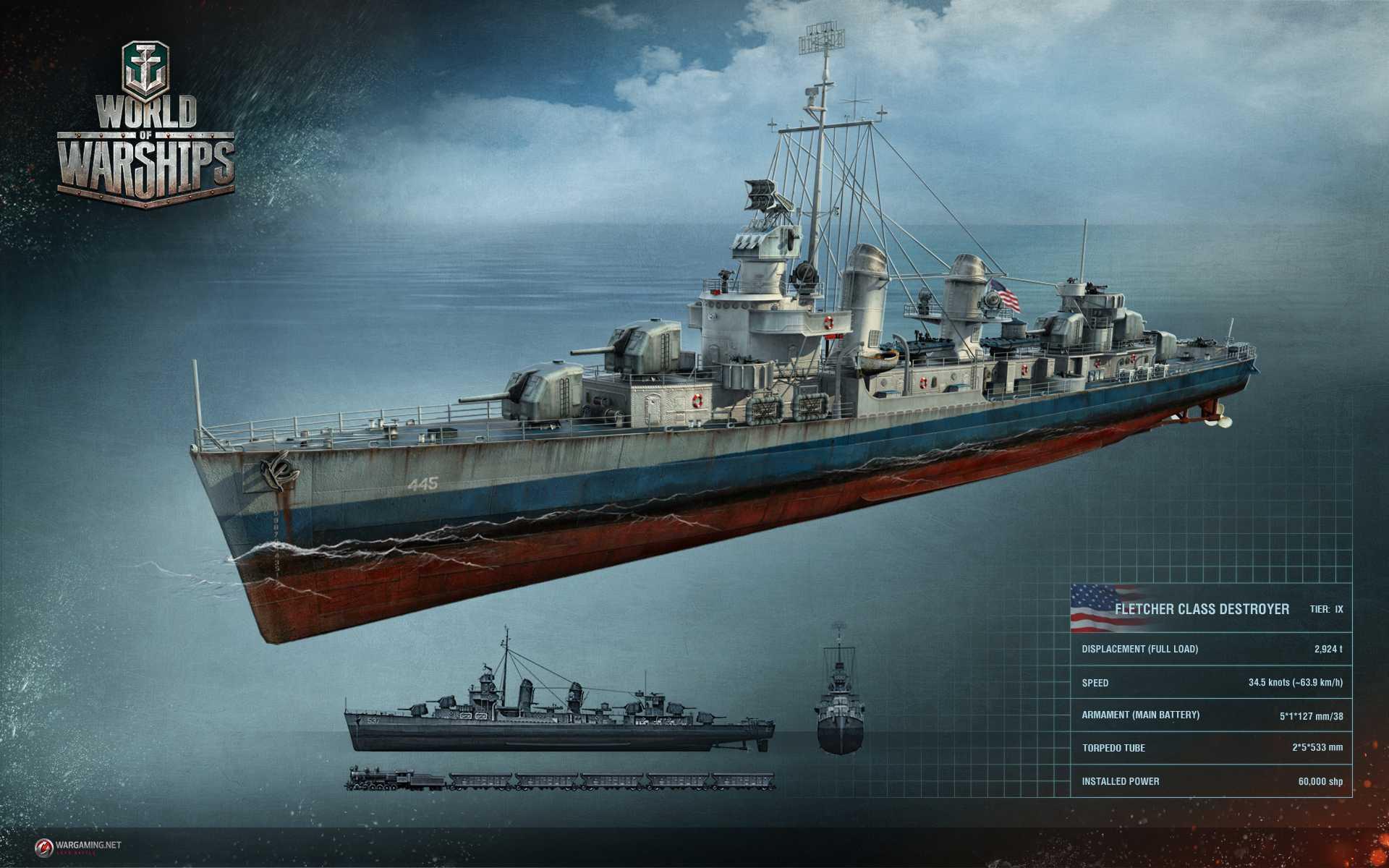World of Warships USA destroyers tech tree
Source – http://blog.worldofwarships.eu/tech-trees-american-destroyers/
The US Navy destroyers’ research tree begins at Tier II
II Sampson
 The Sampson was the first U.S. destroyer with a displacement exceeding 1,000 tons. She laid down the guidelines of development for the further generations of destroyers. The Sampson was armed with four torpedo tubes, but as they were mounted on the broadsides, she could only shoot two of them in one salvo. The speed of 30 knots was enough to compensate this shortcoming and allowed for active maneuvering during battles.
The Sampson was the first U.S. destroyer with a displacement exceeding 1,000 tons. She laid down the guidelines of development for the further generations of destroyers. The Sampson was armed with four torpedo tubes, but as they were mounted on the broadsides, she could only shoot two of them in one salvo. The speed of 30 knots was enough to compensate this shortcoming and allowed for active maneuvering during battles.
Il Sampson è stato il primo cacciatorpediniere STATUNITENSE con una sstazza superiore a 1.000 tonnellate. Ha stabilito le linee guida di sviluppo per le successive generazioni di cacciatorpediniere. Il Sampson era armato con quattro tubi lanciasiluri fissi, ma montati sulle murate e così poteva solo sparare due di essi in una salva. La velocità di 30 nodi è sufficiente a compensare questa carenza e per manovra attiva durante le battaglie.
III Wickes
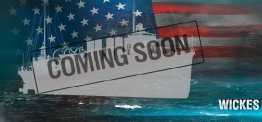 The Wickes-class destroyers did not have an elevation on the bow called a forecastle. This design is known as a “flush deck” hull. The Wickes used the same armament and armor as her predecessor, but had an increased speed of 35 knots and a more effective type of torpedoes.
The Wickes-class destroyers did not have an elevation on the bow called a forecastle. This design is known as a “flush deck” hull. The Wickes used the same armament and armor as her predecessor, but had an increased speed of 35 knots and a more effective type of torpedoes.
La classe Wickes non aveva un arco sul castello di prua. Questo progetto fu noto come “flush deck” dello scafo. Il Wickes usava lo stesso armamento e corazza della classe precedente, ma ebbe un aumento della velocità di 35 nodi e ad un più efficace tipo di siluri.
IV Clemson
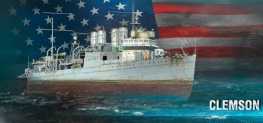 The Clemson was a “flush deck” destroyer class that included 156 ships. Most of the characteristics, such as the speed and the torpedo armament, remained unchanged as compared to her predecessor. However, in the course of production the U.S. fleet command decided to increase the firepower of these ships by installing twin-barrel primary armament guns. As a result, players can research and install up to eight 102 mm (4 in) guns on the destroyer.
The Clemson was a “flush deck” destroyer class that included 156 ships. Most of the characteristics, such as the speed and the torpedo armament, remained unchanged as compared to her predecessor. However, in the course of production the U.S. fleet command decided to increase the firepower of these ships by installing twin-barrel primary armament guns. As a result, players can research and install up to eight 102 mm (4 in) guns on the destroyer.
La Clemson era una classe di cacciatorpediniere con “flush deck” che comprendeva 156 navi. La maggior parte delle caratteristiche, come la velocità e i siluri, rimase invariato rispetto al predecessore. Tuttavia, nel corso della produzione, il comando della flotta USA decise di aumentare la potenza di fuoco di queste navi installando cannoni binati come armamento principale. Di conseguenza, i giocatori possono ricercare e installare fino a otto 102 mm (4 in) sul cacciatorpediniere.
V Destroyer Leader (1919 Project)
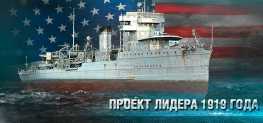 A project of the destroyer leader developed on the basis of the Clemson class. The ship’s displacement considerably increased in comparison with her prototype. The armament included five 127 mm (5 in) artillery guns and four triple-mount torpedo tubes. Players can replace one of the primary armament turrets with an anti-aircraft battery, which is indispensable when fighting enemy aircraft carriers. Despite its great potential, the project was not realized due to financial cuts after World War I.
A project of the destroyer leader developed on the basis of the Clemson class. The ship’s displacement considerably increased in comparison with her prototype. The armament included five 127 mm (5 in) artillery guns and four triple-mount torpedo tubes. Players can replace one of the primary armament turrets with an anti-aircraft battery, which is indispensable when fighting enemy aircraft carriers. Despite its great potential, the project was not realized due to financial cuts after World War I.
Un progetto di cacciatorpediniere sviluppato sulla base della classe Clemson. La stazza della nave è aumentata considerevolmente in confronto al suo prototipo. L’armamento comprendeva cinque 127 mm (5 pollici) e quattro lanciasiluri trinati. I giocatori possono sostituire una delle torrette principali con una batteria contraerea, che è indispensabile nella lotta contro gli aerei nemici. Nonostante il suo grande potenziale, il progetto non fu realizzato a causa di tagli finanziari dopo la Prima Guerra Mondiale.
VI Farragut
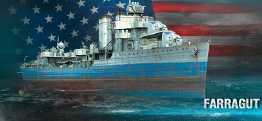 The Farragut carried the newest 127 mm (5 in) guns that became the primary armament for many subsequent destroyer classes, and served as auxiliary guns for further cruisers and battleships. She had bigger displacement than her predecessors, except for the Destroyer Leader (1919 Project). The torpedo armament consisted of two quadruple tubes. The project proved to be very successful and served as a prototype for almost all of the subsequent U.S. destroyer classes.
The Farragut carried the newest 127 mm (5 in) guns that became the primary armament for many subsequent destroyer classes, and served as auxiliary guns for further cruisers and battleships. She had bigger displacement than her predecessors, except for the Destroyer Leader (1919 Project). The torpedo armament consisted of two quadruple tubes. The project proved to be very successful and served as a prototype for almost all of the subsequent U.S. destroyer classes.
la classe Farragut aveva i nuovissimi 127 mm (5 pollici) che divennero il principale armamento per molti altri cacciatorpediniere, ed è servirono come cannoni ausiliari per incrociatori e corazzate. Questa classe aveva un dislocamento maggiore dei suoi predecessori, tranne il cacciatorpediniere Leader (1919). I siluri venivano lanciati da due lanciasiluri quadrinati. Il progetto si è rivelato un grande successo e servì come un prototipo per quasi tutto le successive classi di cacciatorpediniere USA.
VII Mahan
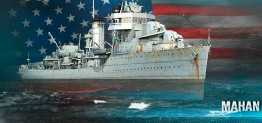 The Mahan was a further development of the Farragut class. She had bigger displacement and an additional torpedo launcher. However, due to the side mounting of the second and the third torpedo launchers, the broadside remained the same as the Farragut’s. During research, players can replace one of the primary armament turrets with an anti-aircraft guns battery, significantly increasing the ship’s anti-aircraft defense.
The Mahan was a further development of the Farragut class. She had bigger displacement and an additional torpedo launcher. However, due to the side mounting of the second and the third torpedo launchers, the broadside remained the same as the Farragut’s. During research, players can replace one of the primary armament turrets with an anti-aircraft guns battery, significantly increasing the ship’s anti-aircraft defense.
La classe Mahan è stata un ulteriore sviluppo della classe Farragut. Aveva un più grande dislocamento e un’ulteriore postazione lancia siluri. Tuttavia, a causa del montaggio laterale del secondo e terzo lanciasiluri, la potenza di fuoco della fiancata rimase la stessa della Farragut. Durante la ricerca, i giocatori possono sostituire uno dei principali armamenti delle torrette con batterie antiaeree, aumentando notevolmente la difesa antiaerea.
VIII Benson
 The Benson-class destroyers are the first of the U.S. research tree to have the five-tube torpedo launchers. As a result, the maximal broadside is increased to ten torpedoes. The destroyer features new primary armament turrets that give her the advantage of an increased artillery fire.
The Benson-class destroyers are the first of the U.S. research tree to have the five-tube torpedo launchers. As a result, the maximal broadside is increased to ten torpedoes. The destroyer features new primary armament turrets that give her the advantage of an increased artillery fire.
la classe Benson è la prima ad avere batterie da cinque tubi lanciasiluri. Di conseguenza, la massima potenza di fuoco in fiancata è aumentata di dieci siluri. Il cacciatorpediniere è dotato torrette con cannoni principali più potenti che danno il vantaggio di un maggiore fuoco d’artiglieria.
IX Fletcher
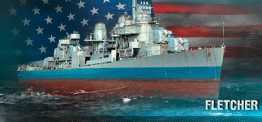 The Fletcher-class is world-renowned as the most produced destroyer of the US Navy fleet with a total of 175 ships commissioned. The Fletcher-class was designed when the U.S. had already withdrawn from the London Naval Treaty. As a result, the Fletchers had a much greater displacement. The engine room was rather well armored against shrapnel hits of high-explosive shells. The ship carried a new type of torpedoes that were only slightly inferior to the famous Long Lance torpedoes.
The Fletcher-class is world-renowned as the most produced destroyer of the US Navy fleet with a total of 175 ships commissioned. The Fletcher-class was designed when the U.S. had already withdrawn from the London Naval Treaty. As a result, the Fletchers had a much greater displacement. The engine room was rather well armored against shrapnel hits of high-explosive shells. The ship carried a new type of torpedoes that were only slightly inferior to the famous Long Lance torpedoes.
la classe Fletcher è conosciuta in tutto il mondo come la più prodotta della flotta US Navy con un totale di 175 navi commissionate. La classe è stato progettata nel momento in cui gli USA si erano già ritirati dal trattato di Londra. Di conseguenza, il Fletcher aveva una cilindrata maggiore. Il motore era ben corazzato contro le schegge e colpi di proiettili esplosivi. La nave trasportava un nuovo tipo di siluri che erano solo leggermente inferiori ai famosi siluri Long Lance.
X Gearing
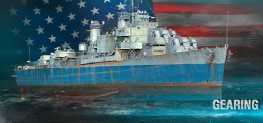 The Gearing-class destroyers together with the Fletcher-class and the Allen M. Sumner-class were the core of the post-war U.S. fleet. Some of the Gearing-class ships remained on active duty until the 1990s. Unlike most of her predecessors, the destroyer’s primary armament guns were mounted in pairs in several turrets. The spare place on the deck was used to install additional antiaircraft batteries.
The Gearing-class destroyers together with the Fletcher-class and the Allen M. Sumner-class were the core of the post-war U.S. fleet. Some of the Gearing-class ships remained on active duty until the 1990s. Unlike most of her predecessors, the destroyer’s primary armament guns were mounted in pairs in several turrets. The spare place on the deck was used to install additional antiaircraft batteries.
la classe Gearing insieme alla classe Fletcher e la Allen M. Sumner è stata il nucleo della flotta post bellica DEGLI STATI UNITI. Alcune navi di questa classe sono rimasto in servizio attivo fino al 1990. A differenza della maggior parte dei suoi predecessori, i cannoni dell’armamento principale sono stati montati a coppie in diverse torrette. Lo spazio rimanente del ponte è stato utilizzato per installare ulteriori batterie antiaeree.
